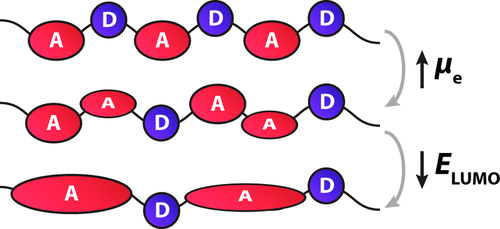当前位置:
X-MOL 学术
›
Chem. Mater.
›
论文详情
Our official English website, www.x-mol.net, welcomes your feedback! (Note: you will need to create a separate account there.)
Effect of Acceptor Unit Length and Planarity on the Optoelectronic Properties of Isoindigo–Thiophene Donor–Acceptor Polymers
Chemistry of Materials ( IF 8.6 ) Pub Date : 2018-06-20 00:00:00 , DOI: 10.1021/acs.chemmater.8b02535 Nicholas M. Randell 1 , Chase L. Radford 1 , Jinli Yang 1 , Jesse Quinn 2 , Dongliang Hou 2 , Yuning Li 2 , Timothy L. Kelly 1
Chemistry of Materials ( IF 8.6 ) Pub Date : 2018-06-20 00:00:00 , DOI: 10.1021/acs.chemmater.8b02535 Nicholas M. Randell 1 , Chase L. Radford 1 , Jinli Yang 1 , Jesse Quinn 2 , Dongliang Hou 2 , Yuning Li 2 , Timothy L. Kelly 1
Affiliation

|
Conjugated polymers with a donor–acceptor (DA) structural motif have found extensive use in a wide variety of optoelectronic devices; however, despite their ubiquity in the literature, the vast majority of these materials are simple alternating copolymers—one electron donor alternates with one electron acceptor in the polymer backbone. As a result, the impact of composition (e.g., donor/acceptor ratio) and structure (e.g., alternating, block, or random) on the optoelectronic properties of these copolymers remains poorly understood. In this work, the number of acceptor units in alternating DA copolymers is systematically increased. Two dimers of the common electron acceptor isoindigo are synthesized, one with free rotation between the subunits and one with enforced coplanarity. The two dimers are then used to synthesize donor–acceptor–acceptor (DAA) copolymers with either thiophene or terthiophene comonomers. These DAA polymers feature two electron acceptors in their repeat unit, and their optoelectronic properties are compared to those of the analogous DA polymers. It is shown that increasing the number of acceptor units causes a decrease in the LUMO energy of the resulting polymer; this effect is enhanced by enforcing coplanarity between acceptor units via ring fusion. All six polymers were tested in both organic photovoltaics (OPVs) and organic thin film transistors (OTFTs). While the DA polymers performed better in OPVs, the DAA polymers displayed more balanced charge carrier mobilities in OTFTs.
中文翻译:

受体单元长度和平面度对异靛-噻吩供体-受体聚合物光电性能的影响
具有供体-受体(DA)结构基序的共轭聚合物已在多种光电器件中得到了广泛的应用。然而,尽管它们在文献中普遍存在,但这些材料中的绝大多数是简单的交替共聚物-在聚合物主链中一个电子供体与一个电子受体交替。结果,对于这些共聚物的光电性能的组成(例如,供体/受体比例)和结构(例如,交替,嵌段或无规)的影响仍然知之甚少。在这项工作中,系统地增加了交替DA共聚物中受体单元的数量。合成了两种普通电子受体异靛蓝的二聚体,一种在亚基之间自由旋转,另一种具有增强的共平面性。然后使用这两个二聚体与噻吩或对噻吩共聚单体合成供体-受体-受体(DAA)共聚物。这些DAA聚合物在其重复单元中具有两个电子受体,并将其光电性能与类似的DA聚合物进行比较。结果表明,增加受体单元的数量会降低所得聚合物的LUMO能量;通过环融合增强受体单元之间的共面性,可以增强这种效果。所有六种聚合物均在有机光伏(OPV)和有机薄膜晶体管(OTFT)中进行了测试。虽然DA聚合物在OPV中表现更好,但DAA聚合物在OTFT中显示出更加平衡的电荷载流子迁移率。这些DAA聚合物在其重复单元中具有两个电子受体,并将其光电性能与类似的DA聚合物进行比较。结果表明,增加受体单元的数量会降低所得聚合物的LUMO能量;通过环融合增强受体单元之间的共面性,可以增强这种效果。所有六种聚合物均在有机光伏(OPV)和有机薄膜晶体管(OTFT)中进行了测试。虽然DA聚合物在OPV中表现更好,但DAA聚合物在OTFT中显示出更加平衡的电荷载流子迁移率。这些DAA聚合物在其重复单元中具有两个电子受体,并将其光电性能与类似的DA聚合物进行比较。结果表明,增加受体单元的数量会降低所得聚合物的LUMO能量;通过环融合加强受体单元之间的共面性,可以增强这种效果。所有六种聚合物均在有机光伏(OPV)和有机薄膜晶体管(OTFT)中进行了测试。虽然DA聚合物在OPV中表现更好,但DAA聚合物在OTFT中显示出更加平衡的电荷载流子迁移率。通过环融合增强受体单元之间的共面性,可以增强这种效果。所有六种聚合物均在有机光伏(OPV)和有机薄膜晶体管(OTFT)中进行了测试。虽然DA聚合物在OPV中表现更好,但DAA聚合物在OTFT中显示出更加平衡的电荷载流子迁移率。通过环融合增强受体单元之间的共面性,可以增强这种效果。所有六种聚合物均在有机光伏(OPV)和有机薄膜晶体管(OTFT)中进行了测试。虽然DA聚合物在OPV中表现更好,但DAA聚合物在OTFT中显示出更加平衡的电荷载流子迁移率。
更新日期:2018-06-20
中文翻译:

受体单元长度和平面度对异靛-噻吩供体-受体聚合物光电性能的影响
具有供体-受体(DA)结构基序的共轭聚合物已在多种光电器件中得到了广泛的应用。然而,尽管它们在文献中普遍存在,但这些材料中的绝大多数是简单的交替共聚物-在聚合物主链中一个电子供体与一个电子受体交替。结果,对于这些共聚物的光电性能的组成(例如,供体/受体比例)和结构(例如,交替,嵌段或无规)的影响仍然知之甚少。在这项工作中,系统地增加了交替DA共聚物中受体单元的数量。合成了两种普通电子受体异靛蓝的二聚体,一种在亚基之间自由旋转,另一种具有增强的共平面性。然后使用这两个二聚体与噻吩或对噻吩共聚单体合成供体-受体-受体(DAA)共聚物。这些DAA聚合物在其重复单元中具有两个电子受体,并将其光电性能与类似的DA聚合物进行比较。结果表明,增加受体单元的数量会降低所得聚合物的LUMO能量;通过环融合增强受体单元之间的共面性,可以增强这种效果。所有六种聚合物均在有机光伏(OPV)和有机薄膜晶体管(OTFT)中进行了测试。虽然DA聚合物在OPV中表现更好,但DAA聚合物在OTFT中显示出更加平衡的电荷载流子迁移率。这些DAA聚合物在其重复单元中具有两个电子受体,并将其光电性能与类似的DA聚合物进行比较。结果表明,增加受体单元的数量会降低所得聚合物的LUMO能量;通过环融合增强受体单元之间的共面性,可以增强这种效果。所有六种聚合物均在有机光伏(OPV)和有机薄膜晶体管(OTFT)中进行了测试。虽然DA聚合物在OPV中表现更好,但DAA聚合物在OTFT中显示出更加平衡的电荷载流子迁移率。这些DAA聚合物在其重复单元中具有两个电子受体,并将其光电性能与类似的DA聚合物进行比较。结果表明,增加受体单元的数量会降低所得聚合物的LUMO能量;通过环融合加强受体单元之间的共面性,可以增强这种效果。所有六种聚合物均在有机光伏(OPV)和有机薄膜晶体管(OTFT)中进行了测试。虽然DA聚合物在OPV中表现更好,但DAA聚合物在OTFT中显示出更加平衡的电荷载流子迁移率。通过环融合增强受体单元之间的共面性,可以增强这种效果。所有六种聚合物均在有机光伏(OPV)和有机薄膜晶体管(OTFT)中进行了测试。虽然DA聚合物在OPV中表现更好,但DAA聚合物在OTFT中显示出更加平衡的电荷载流子迁移率。通过环融合增强受体单元之间的共面性,可以增强这种效果。所有六种聚合物均在有机光伏(OPV)和有机薄膜晶体管(OTFT)中进行了测试。虽然DA聚合物在OPV中表现更好,但DAA聚合物在OTFT中显示出更加平衡的电荷载流子迁移率。



























 京公网安备 11010802027423号
京公网安备 11010802027423号